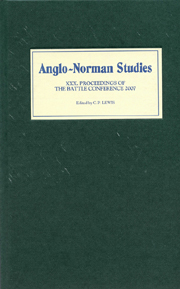Book contents
- Frontmatter
- Contents
- LIST OF ILLUSTRATIONS, MAPS, AND TABLES
- EDITOR'S PREFACE
- ABBREVIATIONS
- The Normans in Welsh History (R. Allen Brown Memorial Lecture)
- William Marshal, Lancelot, and Arthur: Chivalry and Kingship
- Grades of Ordination and Clerical Careers, c. 900–c. 1200
- Evesham J and Evesham L: Two Early Twelfth-Century Manorial Surveys
- Aspects of Church Reform in Wales, c. 1093–c. 1223
- Lay Charters and the Acta of Henry II
- Reinventing Normans as Crusaders? Ralph of Caen's Gesta Tancredi
- Kings, Lords, Charters, and the Political Culture of Twelfth-Century Wales
- Identifying the Warrior on the Pre-Heraldic Battlefield
- St Nicholas the Pilgrim and the City of Trani between Greeks and Normans, c. 1090–c. 1140
- The ‘Resurgence’ of Powys in the Late Eleventh and Early Twelfth Centuries
- Interpreter Families and Anglo-Welsh Relations in the Shropshire-Powys Marches in the Twelfth Century
- A Taste for the Antique? Henry of Blois and the Arts
Interpreter Families and Anglo-Welsh Relations in the Shropshire-Powys Marches in the Twelfth Century
Published online by Cambridge University Press: 12 September 2012
- Frontmatter
- Contents
- LIST OF ILLUSTRATIONS, MAPS, AND TABLES
- EDITOR'S PREFACE
- ABBREVIATIONS
- The Normans in Welsh History (R. Allen Brown Memorial Lecture)
- William Marshal, Lancelot, and Arthur: Chivalry and Kingship
- Grades of Ordination and Clerical Careers, c. 900–c. 1200
- Evesham J and Evesham L: Two Early Twelfth-Century Manorial Surveys
- Aspects of Church Reform in Wales, c. 1093–c. 1223
- Lay Charters and the Acta of Henry II
- Reinventing Normans as Crusaders? Ralph of Caen's Gesta Tancredi
- Kings, Lords, Charters, and the Political Culture of Twelfth-Century Wales
- Identifying the Warrior on the Pre-Heraldic Battlefield
- St Nicholas the Pilgrim and the City of Trani between Greeks and Normans, c. 1090–c. 1140
- The ‘Resurgence’ of Powys in the Late Eleventh and Early Twelfth Centuries
- Interpreter Families and Anglo-Welsh Relations in the Shropshire-Powys Marches in the Twelfth Century
- A Taste for the Antique? Henry of Blois and the Arts
Summary
Biographies of medieval English rulers tend to describe Anglo-Welsh relations in terms of a king's Welsh policy – that is, composing a ‘top-down’ narrative analysis focusing on an English ruler and the contemporary Welsh ones. However, close examination of the careers and fortunes of two families of March interpreters who held lands near the geographical nexus where the Welsh polities of Gwynedd and Powys were juxtaposed with the English counties of Cheshire and Shropshire will supply a more nuanced description of border events during the twelfth century and the reasons for those events.
The first of these families is the six-generation lineage of Rhys Sais and Roger of Powys, as displayed in Figure 1. It is striking that the first piece of written evidence about Roger, a charter from the cartulary of Haughmond abbey issued by William fitz Alan on 25 July 1155, shows him to be a significant figure in Shropshire already by that time. In July 1155 William had recently returned to Shropshire accompanying King Henry II while the latter besieged Cleobury, Wigmore, and Bridgnorth castles to gain control of them from Hugh Mortimer. In the aftermath of these successful sieges William fitz Alan regained control over his lands in Shropshire when the king officially regranted them to him. William's feudal tenants in Shropshire then renewed their homage to him. The charter just mentioned, by which William granted the advowson of Wroxeter to Haughmond abbey, which the fitz Alans had founded earlier in the twelfth century, was part of the pattern of William re-establishing his family's position in the county.
- Type
- Chapter
- Information
- Anglo-Norman Studies 30Proceedings of the Battle Conference 2007, pp. 196 - 212Publisher: Boydell & BrewerPrint publication year: 2008



